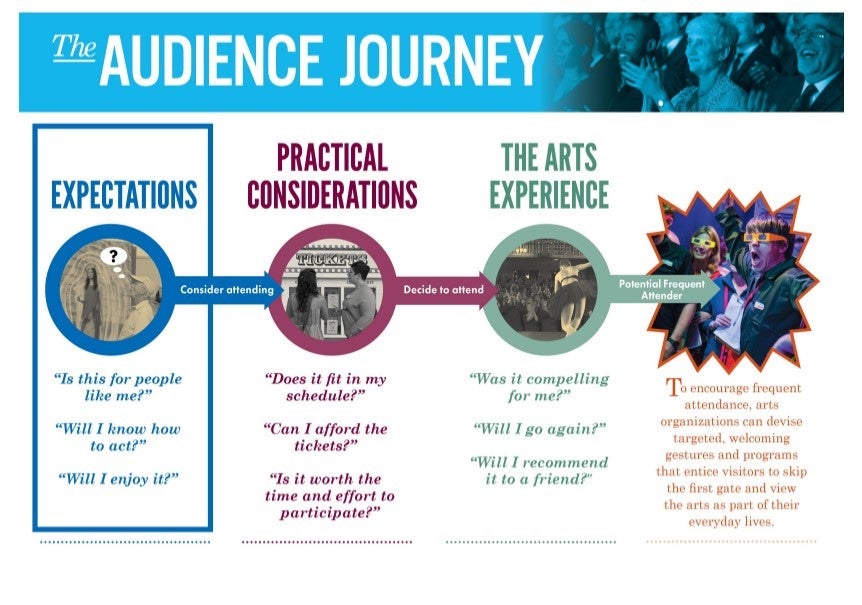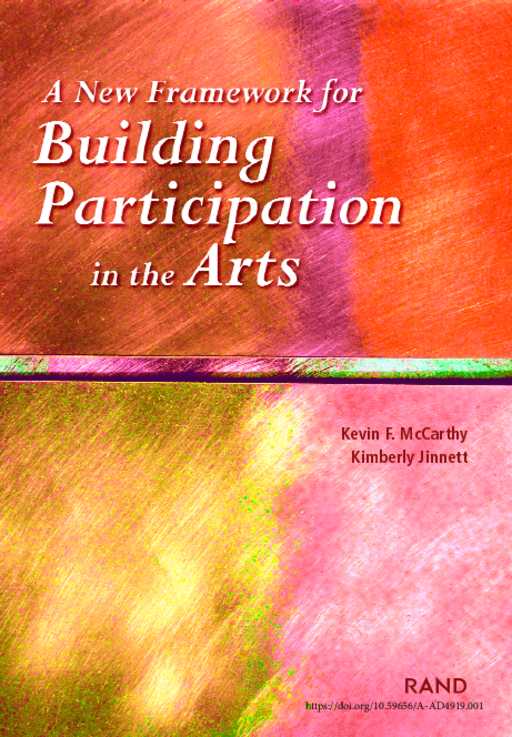Breadcrumb
- Wallace
- Reports
- A New Framework For Building Par...
A New Framework for Building Participation in the Arts

- Author(s)
- Kevin F. McCarthy and Kimberly Jinnett
- Publisher(s)
- RAND Corporation
Summary
How we did this
This report is based on a review of research, site visits at 13 arts institutions, and a telephone survey of 102 arts organizations in the United States. The RAND team developed and refined a theoretical model to examine the factors that are most likely to influence an individual’s decision to participate in the arts.
This landmark study describes a framework arts organizations can use to systematically build audiences for the arts.
Many arts institutions seek to do more than expand their markets and increase their revenues. They also want to broaden the definition of art and reinvigorate themselves. But typically they lack the expertise and resources needed to design and put in place effective approaches. As a result, they tend to use hit-or-miss strategies, ending up uncertain about why what they tried did or did not work.
To better understand these developments, Wallace commissioned RAND to examine how arts organizations:
- Attract new audiences
- Reach a larger share of existing audiences
- Deepen the involvement of current participants
How to Boost Participation
Researchers found that arts institutions can increase participation in three ways:
- By broadening it—capturing a larger share of the existing market by attracting people who are a natural audience, but are not currently participants
- By deepening it—intensifying current participants’ level of involvement
- By diversifying it—attracting new people who typically would not entertain the idea of participating in an art form
Institutions also need to consider not just what to do but also when and for whom to do it.
Lowering prices, for example, may be enough to convince some potential participants to “give it a try,” but may have little or no effect on others. With that in mind, the researchers present a behavioral model of the different stages an individual goes through in making participation decisions and the barriers or influences they face in each:
- Perceptual stage. This includes expectations likely to prevent people from participation. An individual might feel, for example, that an art form is unappealing or unapproachable.
- Practical stage. Participants encounter real-world obstacles. For example, performances might be held at an inconvenient time or location.
- Experience stage. If the practical barriers can be overcome, an individual might participate in a specific arts event and their reaction to the experience then influences their next decisions about whether to participate.

An arts organization’s participation-building strategies must be tailored both to its target population and to its broader institutional context.
Matching Tactics to the Right Stage
Different factors drive decisions at each of these stages. For that reason, the tactics used to influence behavior must fit the stage of the target population.
Specifically:
Efforts to diversify participation are most appropriate for individuals not inclined to participate. These people believe the arts are not likely to be of benefit to them and thus must be persuaded of the benefits they could derive from participation. They are at the stage in the decision-making process where perceptual factors are most relevant.
Efforts to broaden participation are the best fit for those already inclined to participate but not currently doing so. These individuals must be provided with information on what types of programs are available, when, and at what prices, and on why these programs might interest them. This group is at the stage of the process where practical factors are most relevant.
Efforts to deepen participation are most appropriate for people currently participating. The challenge is to convince them to become more involved, which means making their participation more rewarding. This group is at the stage where experience factors are most relevant.
The report also suggests that institutions use what the researchers call an “integrative approach” to audience building. That means ensuring an organization’s efforts are in sync with its purpose and mission, available resources, and the community in which it operates.
Key Takeaways
This landmark study describes a framework that arts organizations can use to think systematically about building audiences for the arts.
The key to effective audience engagement strategies is knowing what tactics to use with which target populations and when.
Arts organizations can increase participation by choosing one of three strategies: broadening it, deepening it, or diversifying it.
Arts organizations should ensure their efforts are in sync with their purpose and mission, available resources, and the community in which they operate.
Visualizations

Materials & Downloads
What We Don't Know
What would results be for organizations chosen at random, rather than from current and former grantees of the Wallace-Reader’s Digest Funds and the Knight Foundation?

